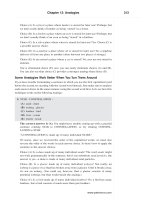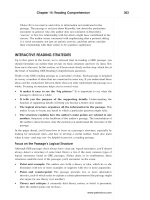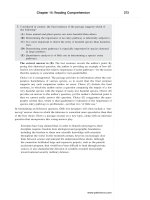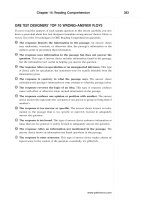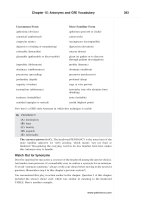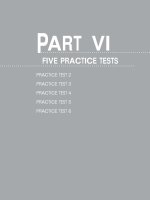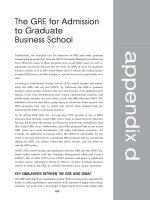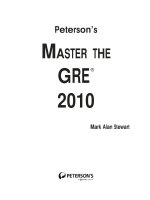Master the Gre 2010 - Part 37
Bạn đang xem bản rút gọn của tài liệu. Xem và tải ngay bản đầy đủ của tài liệu tại đây (50 KB, 10 trang )
expectations when it comes to government rules for business. (Notice the signpost
word “yet,” which signals the contradiction.) Start with the second blank, looking
for a word that accurately captures the public attitude. Choices (A), (B), and (D)
work best; divided, confused, and ambiguous all convey the idea that the public
wants two things that don’t go together very well. For the first blank, you want a
word that describes what the second part of the sentence also describes. Choice
(D) appears to be the best fit; the sentence as a whole has to do with “business
regulation”; that is, the rules laid down by government for business. Two other
choices, (A) and (C), work all right for the first blank. But “ethics” is a bit too
specific, while “practices” is a bit too vague. (Besides, you already eliminated
choice (C) based on the second missing word.)
As you just saw, the semicolon without a connector word might provide a wordless
warning of a restatement. Also look for these key words and phrases, which often
mark restatements:
in fact
in other words
in short
namely
that is
Three of these markers could easily be inserted into the sentence about business
regulation to strengthen the restatement signal. Try reading the sentence again using
each marker in turn, and you’ll find out which three work.
Cause and Effect
In a sentence fitting this pattern, one part describes something that causes, produces, or
influences what’s described in another part. Here’s an example:
13. When waging election campaigns against challengers, most incumbent
politicians have significant _______ as a result of the power and
recognition that are typically part and parcel of holding public office.
(A) propensities
(B) expenses
(C) contributions
(D) budgets
(E) advantages
The correct answer is (E). In this sentence, the operative phrase is as a result.
What precedes this phrase describes the effect or result of the power and recog-
nition that goes with holding an official position in the government. Put another
way, the power and recognition of public office causes or influences what the
earlier part of the sentence intends to describe. Logically, what effects would be
caused by the power and recognition of public office? One natural effect would be
to make it easier to run for reelection, if for no other reason than because the
current officeholder is already well known. So, advantages is an apt expression of
this natural effect. The most tempting wrong answer choices are probably choices
(C) and (D). However, significant contributions or budgets wouldn’t necessarily be
logical or natural effects of having power and recognition. What’s more, the
Chapter 13: Sentence and Text Completions 343
.................................................................
..............................................................................................
TIP
Punctuation, especially colons
and semicolons, is often used
to restate (paraphrase, define,
or elucidate) an idea. But a
key word or phrase can be
used for the same purpose
as well.
www.petersons.com
phrase “have...contributions” is an awkward idiom. (A more effective and
clearer phrase is “receive contributions.”) So choice (C) cannot be the best one.
By the way, to complete the sentence correctly, it helps to know that an
“incumbent politician” is one who is already in office. Even if you don’t know what
incumbent means, you can make an educated guess based on the sentence as a
whole. “Incumbent politicians” are depicted here as running against “chal-
lengers,” and a “challenger” is typically a person who goes up against a current
title holder. So it would be a good guess that an incumbent candidate is the
current office holder.
In the above example, the signpost “as a result” marked the cause-and-effect con-
nection. Here are some other signposts that mark this kind of connection:
because
hence
consequently
due to
leads to
produces
results in
since
therefore
thus
You can redraft the sentence about incumbent candidates using any of these signposts
in place of “as a result.” If you try it, you’ll see that you can simply plug in some as
substitutes for “as a result”; to use others, though, you’d also need to restructure the
sentence.
KEY FACTS ABOUT TEXT COMPLETIONS
The Text Completion format is more complex than the Sentence Completion format. You
first looked at Text Completions in Chapter 2 and in the Diagnostic Test. Let’s quickly
review all the key facts about this format.
Where: The 30-minute Verbal Reasoning section of the computer-based GRE
How Many: 0–1
What’s Tested:
• Your ability to understand the intended meaning of a sentence or paragraph
• Your ability to distinguish between a paragraph that is cohesive and coherent and
one that lacks these qualities
• Your ability to recognize and distinguish between proper and improper word
usage and idiom
• Your ability to recognize and distinguish between a clear and unclear written
expression
Directions: During the computerized GRE, test directions similar to the following
will precede a Text Completion test item:
Directions: Select one entry from each column to fill in the corresponding
blanks in the text. Fill in the blanks in a way that provides the best completion
for the text.
PART V: Verbal Reasoning344
.................................................................
..............................................................................................
NOTE
Only the computer-based GRE
can include a Text Completion
question. This format is not
used at all on the paper-
based test.
www.petersons.com
Other Key Facts:
• A Text Completion involves one to five sentences containing two to three blanks
in all.
• You’ll fill in blanks with either single words or brief phrases.
• You select fill-in choices by clicking directly on them with your mouse.
• The primary emphasis is on idiom, sense, and paragraph structure; secondary
emphasis is on vocabulary.
• You complete each blank independently of the other blank(s).
• You must choose the best completion for all blanks in a question to earn credit for
a correct response; no partial credit is awarded.
• The best choice will make for an excellent sentence or paragraph that’s cohesive,
rhetorically effective, and correct in grammar, diction, and idiom.
THE 4-STEP PLAN (TEXT COMPLETIONS)
Your approach to GRE Text Completions should be similar to your plan for Sentence
Completions. However, in the following step-by-step plan, notice that you don’t formu-
late your own completion (step 2 for Sentence Completions) before weighing the answer
choices. That’s because Text Completions are usually too lengthy and complex for this
strategy.
Step 1: Read the Passage in Its Entirety
Pay particular attention to key words that indicate a description, point of view,
conclusion, comparison, or contrast.
Step 2: Test Each Answer Choice for the First Blank
Eliminate choices that you’re sure are wrong.
Step 3: Test Each Answer Choice for the Second Blank
Eliminate choices that you’re sure are wrong. Repeat for the third blank as needed.
Step 4: Compare Remaining Choices by Rereading the Passage
Compare the remaining choices for all blanks by reading the entire passage again with
each combination. Pay close attention to whether each word or phrase is used properly
and appropriately in context. If you’re still undecided, take your best guess among the
viable choices.
Applying the 4-Step Plan
Now let’s apply this four-step plan to a GRE-style Text Completion. This example is
about as brief as any you’d see on the GRE.
Chapter 13: Sentence and Text Completions 345
.................................................................
..............................................................................................
ALERT!
Don’t assume you’ll be able to
zero in on the best choice for
one blank without considering
the other blank(s) as well. Text
Completions are generally not
designed to be solved
that easily.
www.petersons.com
14. Friends of the theater have long decried the (i)_______ of big-city drama
critics, whose reviews can determine the (ii)_______ a play in a single
night.
Blank (i)
callous indifference
unfettered sway
incisive judgment
Blank (ii)
popularity of
outcome of
audience for
Step 1: To handle this Text Completion, it helps to know that the word decry means
“to discredit or criticize.” If you’re completely unfamiliar with the word, you can at
least guess at its definition. The root cry provides a good clue that decry is a negatively
charged word. As a whole, then, the sentence is describing how a play reviewer’s
action can impact a play in a way that evokes a critical response from the theatrical
community.
Step 2: Let’s weigh the choices for blank (i). It wouldn’t make much sense for “friends
of the theater” to discredit or criticize a drama critic’s “incisive judgment.” (The word
incisive in this context means “keen or sharp.”) So you can at least eliminate this
choice, without even considering blank (ii). But the other two choices both make sense
as a characteristic of big-city drama critics that friends of the theater might not think
highly of. (Of course, it helps to know that unfettered sway means “unconstrained
influence or power.”) So you’ll need to consider blank (ii) to determine the best choice
for blank (i).
Step 3: Now let’s look at the choices for blank (ii). The phrase outcome of doesn’t make
much sense in context. It’s the playwright, not the critic, that determines the outcome
of a play. But the other two choices both seem to make sense: A drama critic’s review
can determine a play’s popularity and its audience. Notice that regardless of which
phrase you use in the second blank, the second part of the sentence provides a better
description of unfettered sway than callous indifference. In other words, the sentence
as a whole is more consistent and cohesive with the former phrase than with the
latter.
Step 4: You need to decide between popularity of and audience for. When you say that
a critic’s review determines a play’s “audience,” aren’t you really saying that it has a
great impact on the size of the audience—that is, the play’s “popularity”? It’s for this
reason that popularity of is the better completion for blank (ii); it makes for a clearer,
more effective sentence. The correct answer is (i) unfettered sway and (ii)
popularity of.
Remember: If you had selected any other choice for either blank, you’d have received
no credit whatsoever for this question. Also, notice the subtle distinction between the
best choice and the runner-up for blank (ii).
Now let’s look at some paragraph-length (two- to five-sentence) Text Completions,
which focus chiefly on idiomatic phrases and sentence transitions. The use of longer
passages allows the test designers to gauge your ability to form cohesive paragraphs
that make sense as a whole and convey the overall idea articulately and properly.
PART V: Verbal Reasoning346
.................................................................
..............................................................................................
ALERT!
In a challenging Text
Completion question, nuances
in meaning can mark the
difference between the best
choice for a blank and the
runner-up.
www.petersons.com
The following example is a bit easier than average for a paragraph-length Text
Completion.
15. Low-context cultures, such as those of the United States, England, and
Germany, spell things out verbally and rely on a rather (i)_______
interpretation of the spoken word. There tends to be no gap between what
is said and what is meant. (ii)_______, high-context cultures, including
those of Spain, France, Mexico, and Japan, communicate more by nuance
and implication, relying less on actual words than on gestures and
situations. In these cultures, (iii)_______ often what is most important.
Blank (i)
literal
straightforward
glib
Blank (ii)
Generally speaking
By the same token
On the other hand
Blank (iii)
what remains unsaid is
what words actually mean is
emphasis and tone are
Let’s apply our four-step approach to this paragraph-length Text Completion.
Step 1: The first two sentences discuss how low-context cultures communicate; the
final two sentences talk about communication in high-context cultures. Based on the
passage’s descriptions, there’s clearly a marked difference between the two. In fact,
this seems to be the paragraph’s main thrust. (Notice the phrases “more by” and “less
on” in the third sentence.)
Step 2: Let’s start with blank (ii), which connects the description of a low-context
culture with the discussion of high-context cultures. Since the text strongly suggests a
contrast, a word like “however” would lead nicely from one to the other. The phrase
On the other hand fits perfectly. (The phrase By the same token signals similarity, not
contrast. The phrase Generally speaking signals an elaboration or explanation just
ahead. Neither phrase is at all appropriate in context.)
Step 3: Notice that the first and second sentences both provide a description of
whatever should fill in blank (i). The second sentence in particular provides a good
definition of the word literally. (The word glib means “fluent or articulate”—not a good
fit for the description in the first two sentences.) On to blank (iii). The final sentence
appears to be a restatement or interpretation of the idea in the preceding sen-
tence—that gestures and implication are more important than actual words. The
phrase what remains unsaid is an artful characterization of what’s gestured or
implied but not put into actual words, so it’s a perfect fit for blank (iii). The other two
phrases confuse the idea; neither one makes the appropriate point.
Step 4: We already determined the best choice for each blank, so we can skip step 4.
The correct answer is (i) literal, (ii) On the other hand, and (iii) what remains
unsaid is.
Now try applying the four steps to another example. This one contains only two
blanks, but that doesn’t mean it’s easier than the previous example.
Chapter 13: Sentence and Text Completions 347
.................................................................
..............................................................................................
www.petersons.com
